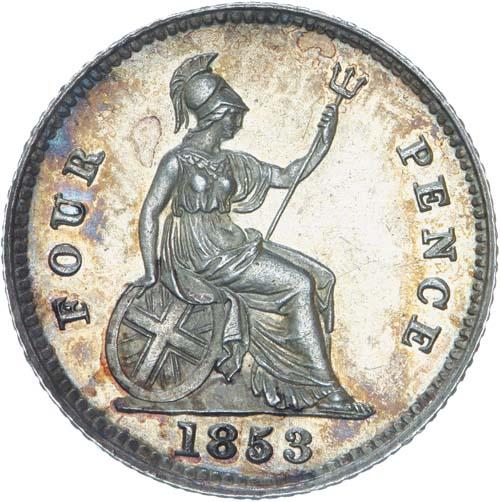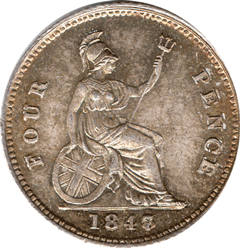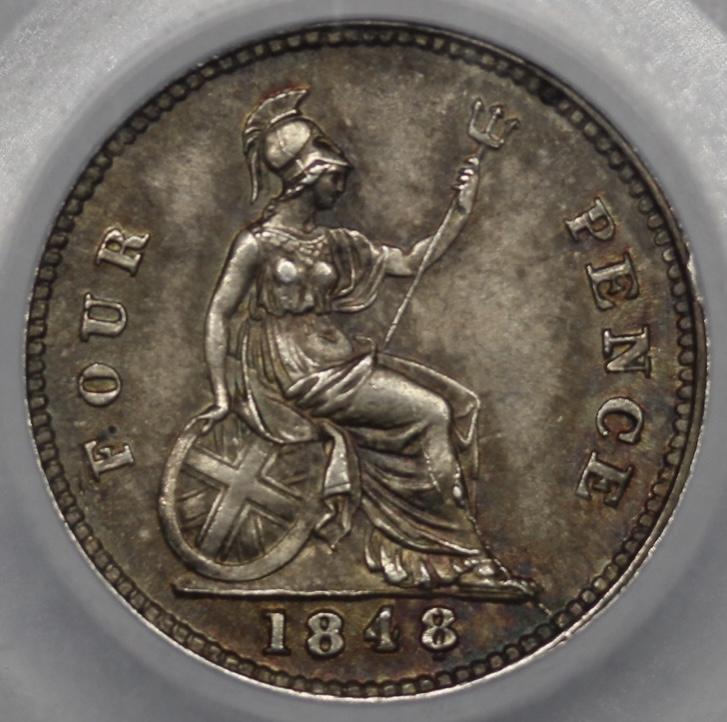
Menger
Unidentified Variety-
Posts
194 -
Joined
-
Last visited
-
Days Won
11
Content Type
Profiles
Forums
Events
Downloads
Store
Gallery
Articles
Everything posted by Menger
-
I think these are “proof” - but they are horizontal axis strikes; maundy in the proof sets of this year were vertical axis strikes. I thus suspect these coins were part of one of the 1839 proof sets reportedly produced in later years. To me this adds to the fascination of the coins. Sadly I am missing the penny (they came with what was clearly a standard Maundy penny - without the same mirror fields, polish marks and frosty devices). Please let me know if you have or ever see a horizontal axis struck “proof” (like) penny that is available!! The die crack in the 3d is identical to that in an NGC graded proof Maundy set currently for sale by Atlas Numismatics - and I suspect that set also was a later strike. (Which would explain the imperfections such as the die crack and less than perfect denticles). I am interested if anyone else in the forum has a different theory on what these may be - or has seen similar.
-
- 1
-

-
Auction House Fees
Menger replied to Kipster's topic in British Coin Related Discussions & Enquiries
It cannot be studied empirically because human preferences vary one person to the next and don’t stay still even for any one person. The amount I will bid is different from you and may change minute to minute - even for identical coins. Logically, however, we can deduce that if someone values a coin more than a given sum of money and less than a incrementally greater sum of money (at a point in time) their bid will (counter factually) go up and down inversely with BP. Presenting only the hammer price in an auction (rather than the total with BP, as Heritage does) cannot change this logic but may cause people to make “mistakes” and bid a sum of money that they value more than the coin. I have done that many times - but I would suggest that it may not be a case of forgetting the BP; rather, in the split second of the bid, I valued the coin more than the money. It was after the hammer fell that I reappraised, my preferences changed - and my hunger switched to regret. The excitement of auctions are designed to exploit this human foible. It is a price we pay for the game - and possibly worth the adrenaline in my view. -
Auction House Fees
Menger replied to Kipster's topic in British Coin Related Discussions & Enquiries
I don’t believe BP makes a jot of difference for dealers (when buying) because I don’t think BP affects the overall price. Buyers adjust their bids to factor in the BP - so the overall price stays the same. BP only affects dealers who then on-sell through an auction - because they effectively pay it at that time (as a seller) to receive their net proceeds. -
Auction House Fees
Menger replied to Kipster's topic in British Coin Related Discussions & Enquiries
Me too. I adjust my bids in light of the total hammer and BP. That is why BP is really a seller’s fee - not a buyer’s fee. If buyers bid the same no matter the premium it would effectively be a fee on buyers - but that is not the case. -
Auction House Fees
Menger replied to Kipster's topic in British Coin Related Discussions & Enquiries
“Buyers’ premium” is really just another form of “Sellers’ fee”, because generally buyers care only about how big a pie they need to exchange for a coin - not a jot how the pie is sliced between the auction house, seller and tax man. It is possible larger or smaller buyers’ premium could have a psychological effect in a particular instance - but in the long run and over buyers broadly, bigger fees just means lower bids and vice versa. Indirectly, because larger buyers fees reduce net proceeds to sellers, it may constrain supply - which will in turn bid up prices, so self correct - but not necessarily so if the auction house merits its cut by better matching supply and demand; and not if other auction houses do better for less. -
My boys (9 and 12) are nuts about collecting Pokémon cards. They have no real interest in coins, but they fully grasp the collecting passion. I suspect that passion is part of the human condition, affects a small minority more than most - and perhaps men more than women. I don’t think money evolving from gold to coins to cheques to credit cards to something else will have any impact at all. I don’t think the association between money and what we collect is relevant - unless you collect the coins of your youth. I collect mainly Victorian. I expect premium tangible artifacts from pre-digital times will only become more sought after as the world becomes evermore virtual - and as networks evolve to better connect sellers and buyers. In this context (short term bubbles apart) coins are well placed for a host of reasons: scarcity, size, prettiness, durability, sophistication of the numismatic art. I also think numismatics will benefit from the inevitable end of woke historical revisionism, once it has run its course - as many societies go through cycles of embracing or rejecting their history. (Perhaps numismatics are already beneficiaries as a refuge to that.) I don’t see woke revisionism lasting in my kids’ generation. They and their friends seem as mythed by it as me. A renaissance may be due …
-
In my collecting sphere, the same could be said for the various proof groats (from 1837, 1853, 1857 and 1862) with anachronistic obverses from later decades. They are “fakes” in a sense, but possibly more valuable than the real McCoy because of their added rarity. On the other hand, high prices for the Maundy masquerading as key date 3d are a case of the market having imperfect knowledge - which I expect will correct.
-
Nobody said “solely”, but “marketing” precisely seeks to affect “demand” (how much people want something). Marketing may be relevant to add luster at the margin of the odd high end rarity from Heritage - or new release from the RM - but the demand aspect of rarity for most coins is established by a more organic, bottom up process (indeed, like “fashion”). Shiny, historically interesting objects are all for the good - but rarity connotes something else. Yes - that is the point - Picasso and Monet may once have been unique (little “supply”), but they were not rarities (and, closely related, had little economic value) until they had matching “demand”. Just like my daughter’s art …
-
Why does rarity matter to collecting? “Rarity” (in the sense we are talking about) is not just “number in existence” (“supply”), but the combination of supply and demand. In “rarity”, a common coin with a unique feature nobody cares about ranks below one with a scarce feature many care about. (My daughter’s art is unique and nobody cares - it is not “a rarity”). Why do we care that other people care? Because that lends the thing an objective quality, as well as subjective. It becomes greater than our own predilections, critical as they are. Put differently, it adds value. That value may manifest in a financial sense, but to a collector it is greater than that. For want of a better word, it is “ spiritual”. That spirituality is what separates the collector from the investor, though we may be both. Amen.
-
LCA catalogue now online
Menger replied to Sword's topic in British Coin Related Discussions & Enquiries
I was concerned after my first London Coins experience jn September as a single £3000 max bid went precisely for that - but in this weekend’s December auction my two bids hammered at about half my maximum. 😊 -
I think the market did a good job of separating the wheat from the chaff. The 1846 3d possibly (from afar) and 1847 3d especially being exceptions (in each case the whole Maundy set seemed a better bargain - but even these were not too exuberant). The 1841 3d went higher than I hoped and it was great to see the robust little 1851 3d do well. I picked up the 1836 groat. The 1847/8 groat was in my view the best piece among them and it got a reasonable price. The NGC slabbed 1853 groat “currency” was rejected by the market as it deserved.
-
1853 currency groat?
Menger replied to Menger's topic in British Coin Related Discussions & Enquiries
I can see now that the Colin Cooke example of the 1853 4d with the third young head is the same coin as sold in the Noble auction in July. I could not bid in that sale due to glitching in Noble’s bid platform. Drat! - that means I have missed it twice in a row. Next time I shall prevail … -
1853 currency groat?
Menger replied to Menger's topic in British Coin Related Discussions & Enquiries
I would be delighted to see any interesting groats. I did not see the Colin Cooke. Was it just listed in their website? There does not appear to be anything there now. -
1853 currency groat?
Menger replied to Menger's topic in British Coin Related Discussions & Enquiries
Thanks. Very nice to see. This seems to be the only one graded as PCGS (if that is right). After my post I got back in touch with NGC and they have now agreed to sort out their population: they will recreate an 1848/7 category and an 1847/6 or 8 category (which will then contain 3 coins, including mine and a details grade). Hooray! I have two other coins with NGC that should be the only examples graded in the NGC census but because they have been submitted for conservation (and the prior numbers not cancelled) the population is now over stated 200% and 300% respectively. I think these population errors must be common. I am now motivated to get NGC to sort those out too. Let’s see what they say … Thanks again for the photo. -
1853 currency groat?
Menger replied to Menger's topic in British Coin Related Discussions & Enquiries
-
1853 currency groat?
Menger replied to Menger's topic in British Coin Related Discussions & Enquiries
-
1853 currency groat?
Menger replied to Menger's topic in British Coin Related Discussions & Enquiries
Thanks. I agree with all of that. I was wondering about the 1846 also. The 1853 has a footnote saying it may be a proof - the lower struck 3 is in the same position as that on a Maundy proof that sold over the summer at Noble. The 1847/6 groat is in my view 1847/8. I am basing this on the analysis by Michael Gouby in his website on the issue - where he argues that the 1847/6 is a misnomer. In any case - the Noonans listed coin is identical to an 1847/8 in my collection. Mine was eventually categorized by NGC as 1847/8 - but only after I complained when they initially labeling it first as 1847/6 and then 1848/7! (That did not impress me!). Finally when I complained again NGC correctly relabeled my coin 1847/8 but at the same time they relabeled the entire category of 1848/7 in their population report as 1847/8!!!! So now they have correctly listed my coin as 1847/8 but have incorrectly listed 4 other coins in the same category as 1847/8 when these were hitherto all 1848/7! I told NGC of their mistake some 8 months ago but nothing has changed yet …. NGC have one other 1847/6 which in my view (following Gouby) is also likely 1847/8. Anyway - the one coming up at Noonans is the second best 1847/8 I have seen. It was sold previously by DNW in June 2017 when they listed it as “1847/6 or 8”. What a muddle! I am interested in any further thoughts you have on the 1853 and 1846 3ds. -
1853 currency groat?
Menger replied to Menger's topic in British Coin Related Discussions & Enquiries
Thanks. Michael Gouby points out on his website that the proofs were minted up beyond the year 1853 - perhaps to the 1880s. Thus as well as proofs mulled with the later young head, Michael identifies proofs with the first young head but worn dies (missing rim teeth). Some of these have been (I believe) presented at auction as currency strikes in recent years but this example is not even that - the rims are intact. While it is possible this is a proof-like currency, I don’t have confidence in NGC to make the distinction based in their seemingly random treatment of maundy, currency and proof 3ds. So I guess it is a coin toss … -
This looks like a proof to me: sharp strike in hair and dense (almost cameo) cheek. The shadows above the FOUR where the tone has not settled looks just like my own proof of that year - presumably from where it spent its early years in a silk lined set box. Any second opinions? https://www.noonans.co.uk/auctions/calendar/661/catalogue/437522/?keywords=Groat&x=0&y=0
-
Score lines or graffiti
Menger replied to Menger's topic in British Coin Related Discussions & Enquiries
Interesting. As I comment above - my take is that the inverted axis for the 1839 proof groat was found in the original 1839 proof set. This being the case in the MDC Monaco set - which is certainly one of the finer ones. By contrast I have 1839 Maundy proofs with both medal and coin axis. Here, I have a always assumed that the medal strikes were more likely from the original proof sets and the coin axis strikes from later restrikes. This is because my coin axis proof Maundy is clearly inferior quality (die cracks and wot not) compared to the medal strike. -
Score lines or graffiti
Menger replied to Menger's topic in British Coin Related Discussions & Enquiries
Correction: I have only seen obverse 1 for the 1839 proof groat. I have only the coin strike variety. This came from what I believe was an original proof set (the set sold in the MDC Monaco sale in Oct 2020 for record money and it had a provenance from Sotheby’s 1856) and so presumably that was the original striking? (I did not buy the set! Only the little groat when it was seemingly broken up after the Monaco sale). -
Score lines or graffiti
Menger replied to Menger's topic in British Coin Related Discussions & Enquiries
-
Score lines or graffiti
Menger replied to Menger's topic in British Coin Related Discussions & Enquiries
Yes - perhaps they were net grading as the obverse is notch or two nicer. Or perhaps they just missed the scoring. CGS had it as UNC 90. -
Score lines or graffiti
Menger replied to Menger's topic in British Coin Related Discussions & Enquiries
Thanks. Yes. That was my guess. Not to produce a circulating coin or a new proof but to recreate marketable restrikes of the 1862 proof (given that we know the obverse being used was not the original from that year and the reverse seems to have been cobbled together - see the lettering all over the place). There was clearly a market for these proof groats from 1837, 1853, 1857 and 1862 (all that appear with later obverse effigies) that appears to have been catered for into the late 60s to 80s (given the first appearance of those effigies). Or perhaps it was just a bloke in a pub with a penknife after all. -
Score lines or graffiti
Menger replied to Menger's topic in British Coin Related Discussions & Enquiries
Yes. The onus would be on a seller if seeking a buyer. I agree the minting stops in the strike. I do think it matters however thereafter whether marking up lines are done by the Mint as part of a process or done by some bloke in a pub with a penknife. It matters to me anyway. 🤣 The groat was graded PF65 by NGC The other coin (which is not mine) is a pattern crown that NGC graded AU55






